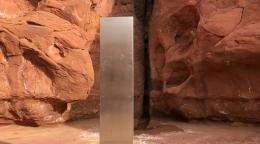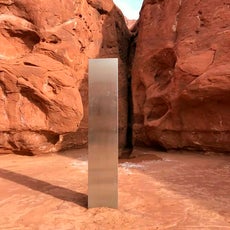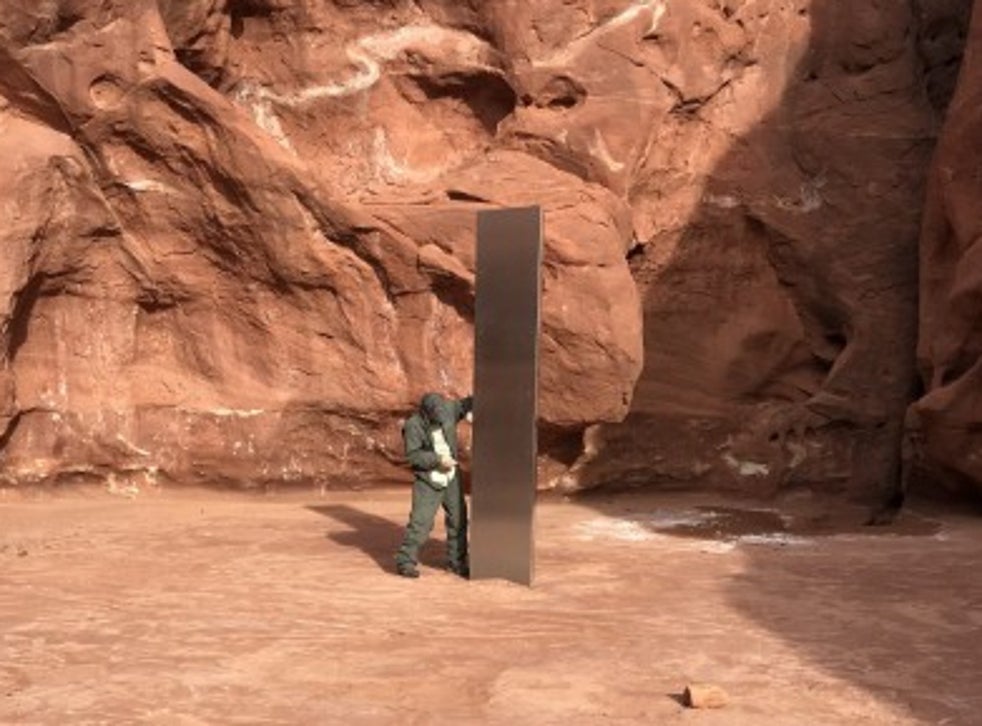Alissa Widman Neese, The Columbus Dispatch
Wed, November 25, 2020

Orphan manatees, Squirrel and Scampi eat lunch alongside longtime manatee resident Stubby, Thursday, November 19, 2020, at the Columbus Zoo and Aquarium. Squirrel, the smallest, has bonded with Stubby faster than any previous calves, and mostly doesn't leave her side. Florida manatees that are federally regulated and the two calves are destined to be returned to the wild.
COLUMBUS, Ohio – When they saw the tiny face full of whiskers surfacing for air in the nearby canal, the Florida residents knew it was time to call for help.
The little manatee's mother wasn't coming back.
Alone, the calf hovered around a large boulder — an object rescuers say she probably became attached to in her mother's absence. She had been alone for more than a day, much longer than a mother would typically leave a calf on its own. When the rescue crew arrived, a man scooped up the 65-pound sea cow in his arms to get her to safety.
"She was not budging from that rock. But thank God she didn't, because it made it really easy to get to her," recalled Mary Stella, spokeswoman for the Dolphin Research Center, based in the Florida Keys, which operates one of several manatee rescue teams in the state. She had a bacterial infection, no food and was getting weaker, with no mom to guide her. She probably would have died."
These days, the calf, named Squirrel, has established a new bond miles away from home — with a manatee admired by many visitors of the Columbus Zoo and Aquarium.
In early November, Stubby, a permanent resident of the zoo's Manatee Coast, became Squirrel's surrogate mom. And keepers say they've never seen her connect with a calf so quickly and closely.
"It was an instant bond," said Becky Ellsworth, curator of the zoo's Shores region, which includes Manatee Coast. "Squirrel's only happy if she's touching Stubby at all times."
Stubby, a fan favorite, has lived at the Columbus Zoo since 2005 — a 15-year reign that, along with her laissez-faire attitude, has earned her the nickname "queen of the zoo." Though she hasn't birthed a calf of her own, she has been a welcoming pool mate for more than 20 rescued orphan manatees that have been rehabilitated at the zoo since her arrival.
Squirrel is among the littlest manatees for which the zoo has tended, Ellsworth said. She has bulked up to more than 130 pounds, though, since her rescue on May 2.
On a recent afternoon, Ellsworth watched as she rested on Stubby's back, and then tagged along for a cruise around the 300,000-gallon Manatee Coast pool.
Squirrel occasionally drifted away, distracted by some scrumptious, floating pieces of romaine lettuce, the main meal of a manatee in human care. But just a few feet of exploring was just a little too much adventure for her. She quickly darted through the water, back to Stubby's side.
Watching is a critical part of caring for manatees. Unlike other zoo animals, the calves are preparing to eventually be released back into the Florida waters from which they were rescued. Too much human interaction could keep them from learning survival skills, so keepers must use a hands-off approach.

COLUMBUS, Ohio – When they saw the tiny face full of whiskers surfacing for air in the nearby canal, the Florida residents knew it was time to call for help.
The little manatee's mother wasn't coming back.
Alone, the calf hovered around a large boulder — an object rescuers say she probably became attached to in her mother's absence. She had been alone for more than a day, much longer than a mother would typically leave a calf on its own. When the rescue crew arrived, a man scooped up the 65-pound sea cow in his arms to get her to safety.
"She was not budging from that rock. But thank God she didn't, because it made it really easy to get to her," recalled Mary Stella, spokeswoman for the Dolphin Research Center, based in the Florida Keys, which operates one of several manatee rescue teams in the state. She had a bacterial infection, no food and was getting weaker, with no mom to guide her. She probably would have died."
These days, the calf, named Squirrel, has established a new bond miles away from home — with a manatee admired by many visitors of the Columbus Zoo and Aquarium.
In early November, Stubby, a permanent resident of the zoo's Manatee Coast, became Squirrel's surrogate mom. And keepers say they've never seen her connect with a calf so quickly and closely.
"It was an instant bond," said Becky Ellsworth, curator of the zoo's Shores region, which includes Manatee Coast. "Squirrel's only happy if she's touching Stubby at all times."
Stubby, a fan favorite, has lived at the Columbus Zoo since 2005 — a 15-year reign that, along with her laissez-faire attitude, has earned her the nickname "queen of the zoo." Though she hasn't birthed a calf of her own, she has been a welcoming pool mate for more than 20 rescued orphan manatees that have been rehabilitated at the zoo since her arrival.
Squirrel is among the littlest manatees for which the zoo has tended, Ellsworth said. She has bulked up to more than 130 pounds, though, since her rescue on May 2.
On a recent afternoon, Ellsworth watched as she rested on Stubby's back, and then tagged along for a cruise around the 300,000-gallon Manatee Coast pool.
Squirrel occasionally drifted away, distracted by some scrumptious, floating pieces of romaine lettuce, the main meal of a manatee in human care. But just a few feet of exploring was just a little too much adventure for her. She quickly darted through the water, back to Stubby's side.
Watching is a critical part of caring for manatees. Unlike other zoo animals, the calves are preparing to eventually be released back into the Florida waters from which they were rescued. Too much human interaction could keep them from learning survival skills, so keepers must use a hands-off approach.

Orphan manatees, Squirrel and Scampi eat lunch alongside longtime manatee resident Stubby, Thursday, November 19, 2020, at the Columbus Zoo and Aquarium. Squirrel, the smallest, has bonded with Stubby faster than any previous calves, and mostly doesn't leave her side. Florida manatees that are federally regulated and the two calves are destined to be returned to the wild.
So instead of hand-feeding, for example, keepers will attach lettuce to a weighted pipe that sinks and toss it in the water from a distance, to re-create the behavior of grazing for natural sea grasses on the ocean floor.
Stubby and Squirrel, along with Scampi, an older, more independent calf who also arrived in Columbus this month, are currently eating 300 heads of lettuce every day.
"We don't want them to associate people with food, or anything," Ellsworth said. "The best thing we can do as their caretakers is let them be manatees."
Stubby is an exception, though. After a boat struck her in the mid 1990s, part of her tail had to be amputated. That means it isn't flat and paddle-shaped like typical manatees'. She also has an undiagnosed skin condition, which causes her to lose weight when it flares up and has left white scars across her body. Recently, it has been under control, and she's bulked up to a healthy 2,000 pounds.
Stubby hasn't been released into the wild because her ongoing health problems would make it very difficult for her to survive, Ellsworth said.
But that means she can be trained to participate in health-care procedures, such as rolling onto her back at the water's surface. While she nibbles on treats, her caretakers can draw blood or collect urine samples.
That training has been put on hold for a while, though, Ellsworth said.
"We would need to separate her from Squirrel, and that's not happening," she joked.
Manatees are federally protected, so only members of an authorized group, the Manatee Rescue and Rehabilitation Partnership, can rescue and care for them. The Columbus Zoo and the Cincinnati Zoo and Botanical Garden are the only program partners located outside Florida.
Over 20 years, the partnership has rescued, rehabilitated and released 618 manatees, according to Andy Garrett, who coordinates rescues for the Florida Fish and Wildlife Conservation Commission. An additional 616 received on-site treatment and were released, for a total of 1,234 manatees assisted.
The Ohio facilities are a crucial part of the partnership, freeing space in the Florida facilities for the sick and injured manatees that need critical care, said Julie Heyde, animal care supervisor at the Miami Seaquarium. The manatees that come to Columbus just need time to grow large enough to survive on their own.
Squirrel and Scampi are the 32nd and 33rd manatee calves to rehab in Columbus.

So instead of hand-feeding, for example, keepers will attach lettuce to a weighted pipe that sinks and toss it in the water from a distance, to re-create the behavior of grazing for natural sea grasses on the ocean floor.
Stubby and Squirrel, along with Scampi, an older, more independent calf who also arrived in Columbus this month, are currently eating 300 heads of lettuce every day.
"We don't want them to associate people with food, or anything," Ellsworth said. "The best thing we can do as their caretakers is let them be manatees."
Stubby is an exception, though. After a boat struck her in the mid 1990s, part of her tail had to be amputated. That means it isn't flat and paddle-shaped like typical manatees'. She also has an undiagnosed skin condition, which causes her to lose weight when it flares up and has left white scars across her body. Recently, it has been under control, and she's bulked up to a healthy 2,000 pounds.
Stubby hasn't been released into the wild because her ongoing health problems would make it very difficult for her to survive, Ellsworth said.
But that means she can be trained to participate in health-care procedures, such as rolling onto her back at the water's surface. While she nibbles on treats, her caretakers can draw blood or collect urine samples.
That training has been put on hold for a while, though, Ellsworth said.
"We would need to separate her from Squirrel, and that's not happening," she joked.
Manatees are federally protected, so only members of an authorized group, the Manatee Rescue and Rehabilitation Partnership, can rescue and care for them. The Columbus Zoo and the Cincinnati Zoo and Botanical Garden are the only program partners located outside Florida.
Over 20 years, the partnership has rescued, rehabilitated and released 618 manatees, according to Andy Garrett, who coordinates rescues for the Florida Fish and Wildlife Conservation Commission. An additional 616 received on-site treatment and were released, for a total of 1,234 manatees assisted.
The Ohio facilities are a crucial part of the partnership, freeing space in the Florida facilities for the sick and injured manatees that need critical care, said Julie Heyde, animal care supervisor at the Miami Seaquarium. The manatees that come to Columbus just need time to grow large enough to survive on their own.
Squirrel and Scampi are the 32nd and 33rd manatee calves to rehab in Columbus.

Andy Clarkson, exhibit artist at the Columbus Zoo and Aquarium, adds two more manatees to the list of those rehabilitated and returned to the wild Thursday, November 19, 2020.
Before she came to Columbus, Stubby resided at SeaWorld Orlando for 10 years. She's currently the only permanent manatee resident in the Midwest. The calves first received care at the Miami Seaquarium.
Scampi was rescued in November 2019 after a boat hit her mother, Jumbo. She became an orphan a few weeks later, when Jumbo died because of her severe lung injuries.
The Seaquarium currently has nine manatees, including three permanent residents, but that number ballooned to as many as 24 a few years ago, Heyde said.
"We don't get much of a break," she said. "Any day, at any time, we may get a call of a manatee in need of rescue."
Tom Stalf, president and CEO of the Columbus Zoo, said the Ohio facilities also help people in the Midwest connect with a species they otherwise might never see.
Until a few years ago, the federal government considered manatees endangered. They're now threatened, with more than 6,500 animals living in the southeastern U.S. and Puerto Rico, mostly in Florida. In 1991, there were only 1,300 in Florida.
In addition to boat strikes, manatees are susceptible to harmful algal blooms and cold stress caused by changes to their habitats, as well as entanglement in discarded fishing gear.
"Our Columbus visitors respect manatees and they love them," Stalf said. "This is conservation in action that you can watch right here in the United States."
The Clearwater Marine Aquarium Research Institute spearheads the research that ensures recently released manatees are thriving, despite these threats.
By fastening a satellite tracking belt around their tails with a bobber attached to it, researchers can monitor manatees to ensure they're eating, socializing and finding warm water when the temperatures drop without them even realizing it, said James "Buddy" Powell, the institute's executive director.
With time, the trackers fall off or are removed.
Eventually, Squirrel will become more independent and the time will come for her to return to the ocean. In the wild, calves usually separate from their mothers by age 2.
Until then, Ellsworth will enjoy watching her learn to become a grownup alongside Stubby.
"She has gone through so much, but she's overcome everything. To me, Stubby is a symbol of using what you have to help others, or making the best of a poor situation," she said. "She's happier for it. Our program is better because of it. Without her, I don't know if we'd have this much success."
Follow Columbus reporter Alissa Widman on Twitter: @AlissaWidman.
This article originally appeared on The Columbus Dispatch: Columbus Zoo: Orphaned manatee calf Squirrel, bonds with surrogate mom
Before she came to Columbus, Stubby resided at SeaWorld Orlando for 10 years. She's currently the only permanent manatee resident in the Midwest. The calves first received care at the Miami Seaquarium.
Scampi was rescued in November 2019 after a boat hit her mother, Jumbo. She became an orphan a few weeks later, when Jumbo died because of her severe lung injuries.
The Seaquarium currently has nine manatees, including three permanent residents, but that number ballooned to as many as 24 a few years ago, Heyde said.
"We don't get much of a break," she said. "Any day, at any time, we may get a call of a manatee in need of rescue."
Tom Stalf, president and CEO of the Columbus Zoo, said the Ohio facilities also help people in the Midwest connect with a species they otherwise might never see.
Until a few years ago, the federal government considered manatees endangered. They're now threatened, with more than 6,500 animals living in the southeastern U.S. and Puerto Rico, mostly in Florida. In 1991, there were only 1,300 in Florida.
In addition to boat strikes, manatees are susceptible to harmful algal blooms and cold stress caused by changes to their habitats, as well as entanglement in discarded fishing gear.
"Our Columbus visitors respect manatees and they love them," Stalf said. "This is conservation in action that you can watch right here in the United States."
The Clearwater Marine Aquarium Research Institute spearheads the research that ensures recently released manatees are thriving, despite these threats.
By fastening a satellite tracking belt around their tails with a bobber attached to it, researchers can monitor manatees to ensure they're eating, socializing and finding warm water when the temperatures drop without them even realizing it, said James "Buddy" Powell, the institute's executive director.
With time, the trackers fall off or are removed.
Eventually, Squirrel will become more independent and the time will come for her to return to the ocean. In the wild, calves usually separate from their mothers by age 2.
Until then, Ellsworth will enjoy watching her learn to become a grownup alongside Stubby.
"She has gone through so much, but she's overcome everything. To me, Stubby is a symbol of using what you have to help others, or making the best of a poor situation," she said. "She's happier for it. Our program is better because of it. Without her, I don't know if we'd have this much success."
Follow Columbus reporter Alissa Widman on Twitter: @AlissaWidman.
This article originally appeared on The Columbus Dispatch: Columbus Zoo: Orphaned manatee calf Squirrel, bonds with surrogate mom





















